ACC8000 Research in Accounting: Agency Theory and Compensation
VerifiedAdded on 2023/06/10
|18
|4529
|281
Report
AI Summary
This report delves into the application of agency theory in structuring effective compensation packages for executives at Terrific Telephone Company. It addresses the limitations of fixed salaries in motivating employees, explores various components of compensation packages like salaries, bonuses, health insurance, stock options, 401(k) contributions, and life insurance, and discusses how these components can incentivize productivity. The report also examines the impact of an employee's risk tolerance on their desired compensation and identifies factors that may limit the effectiveness of performance-based compensation. Furthermore, it highlights the benefits of having an executive compensation committee. The report further explains the role of auditing accounts and financial statements in maintaining transparency and trust between principals and agents, especially concerning investments and regulatory compliance. The analysis integrates agency theory with stakeholder and stewardship theories, providing a comprehensive view of governance in non-profit organizations.

RUNNING HEAD: RESEARCH IN ACCOUNTING PRACTICE
Accounting Research
Accounting Research
Paraphrase This Document
Need a fresh take? Get an instant paraphrase of this document with our AI Paraphraser
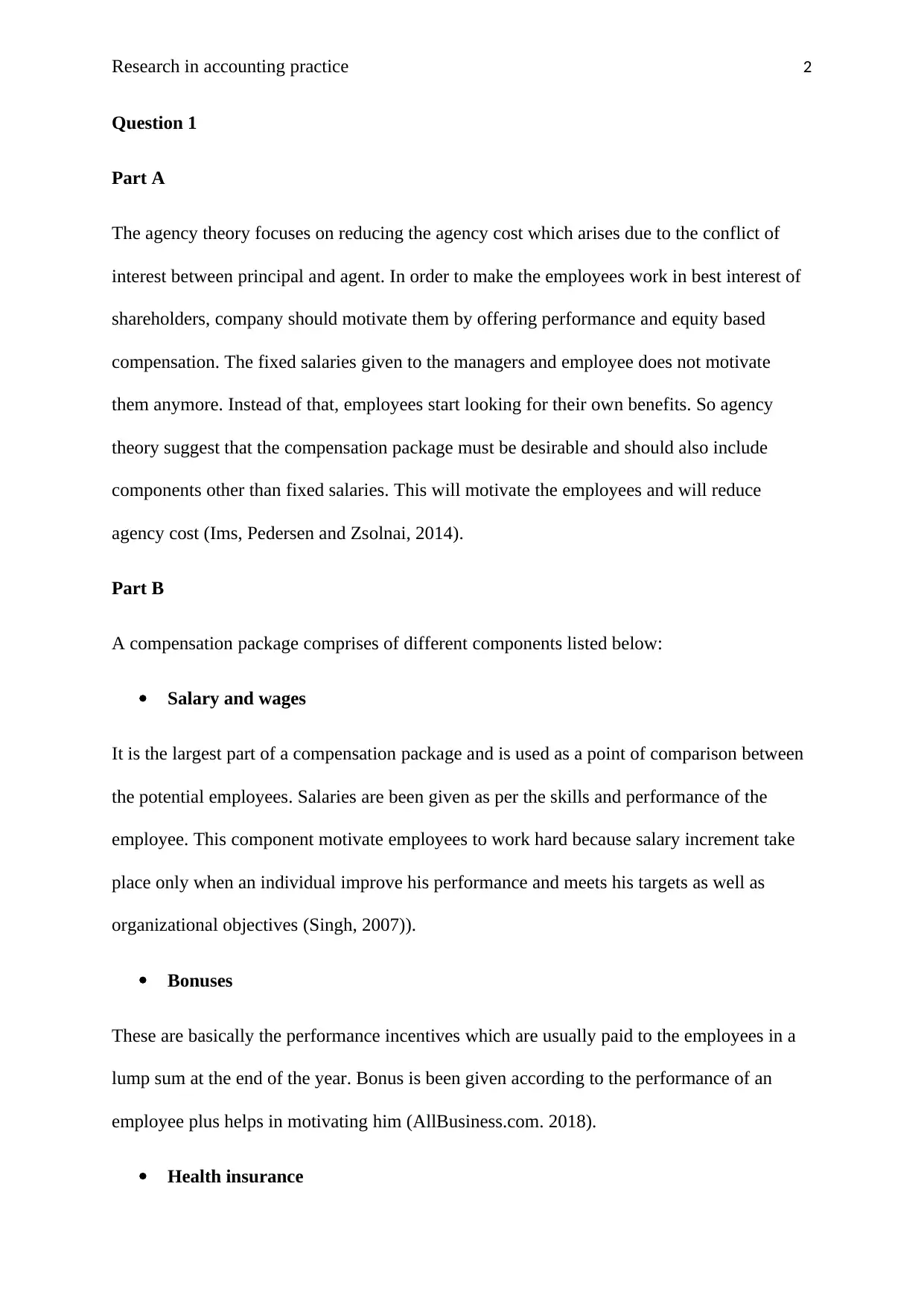
Research in accounting practice 2
Question 1
Part A
The agency theory focuses on reducing the agency cost which arises due to the conflict of
interest between principal and agent. In order to make the employees work in best interest of
shareholders, company should motivate them by offering performance and equity based
compensation. The fixed salaries given to the managers and employee does not motivate
them anymore. Instead of that, employees start looking for their own benefits. So agency
theory suggest that the compensation package must be desirable and should also include
components other than fixed salaries. This will motivate the employees and will reduce
agency cost (Ims, Pedersen and Zsolnai, 2014).
Part B
A compensation package comprises of different components listed below:
Salary and wages
It is the largest part of a compensation package and is used as a point of comparison between
the potential employees. Salaries are been given as per the skills and performance of the
employee. This component motivate employees to work hard because salary increment take
place only when an individual improve his performance and meets his targets as well as
organizational objectives (Singh, 2007)).
Bonuses
These are basically the performance incentives which are usually paid to the employees in a
lump sum at the end of the year. Bonus is been given according to the performance of an
employee plus helps in motivating him (AllBusiness.com. 2018).
Health insurance
Question 1
Part A
The agency theory focuses on reducing the agency cost which arises due to the conflict of
interest between principal and agent. In order to make the employees work in best interest of
shareholders, company should motivate them by offering performance and equity based
compensation. The fixed salaries given to the managers and employee does not motivate
them anymore. Instead of that, employees start looking for their own benefits. So agency
theory suggest that the compensation package must be desirable and should also include
components other than fixed salaries. This will motivate the employees and will reduce
agency cost (Ims, Pedersen and Zsolnai, 2014).
Part B
A compensation package comprises of different components listed below:
Salary and wages
It is the largest part of a compensation package and is used as a point of comparison between
the potential employees. Salaries are been given as per the skills and performance of the
employee. This component motivate employees to work hard because salary increment take
place only when an individual improve his performance and meets his targets as well as
organizational objectives (Singh, 2007)).
Bonuses
These are basically the performance incentives which are usually paid to the employees in a
lump sum at the end of the year. Bonus is been given according to the performance of an
employee plus helps in motivating him (AllBusiness.com. 2018).
Health insurance

Research in accounting practice 3
It includes health insurance of an employee sponsored by employer. Moreover, it is a benefit
of great value to the employees. It save their money and provide them a sense of security that
they would not be denied in their existing health issues. This motivate them to work for
company with full interests (AllBusiness.com. 2018).
Stock options
These are been used by many companies in order to retain, attract and compensate best
employees in the organizations. Stock options are basically a contract between the employees
and employer in which workers or employees are allowed to purchase a specific number of
company’s shares for a given period of time and at a fixed price. This benefit them by
exercising their options when company’s stocks are traded at higher prices which earn them a
certain amount of profit. It motivates them and help the employer to keep them in the
organization (Olagues and Summa, 2010).
401(k) contribution
It is a type of pension plan which is less expensive and more popular. It is included in the
compensation packages of employees because it gives them some control over their
contribution and they have the right to know the manner in which money is invested. Such
plans offer employees a security regarding their contributed amount. As a result of which,
employees feel motivated and are focused (Francis and Schipper, 2011).
Life insurance
This is something related to securing the whole life of an employee. It also cost less when
purchased by the employer. An organization offering life insurance policies in its
compensation packages will definitely attract people and motivate its employees
(AllBusiness.com. 2018).
It includes health insurance of an employee sponsored by employer. Moreover, it is a benefit
of great value to the employees. It save their money and provide them a sense of security that
they would not be denied in their existing health issues. This motivate them to work for
company with full interests (AllBusiness.com. 2018).
Stock options
These are been used by many companies in order to retain, attract and compensate best
employees in the organizations. Stock options are basically a contract between the employees
and employer in which workers or employees are allowed to purchase a specific number of
company’s shares for a given period of time and at a fixed price. This benefit them by
exercising their options when company’s stocks are traded at higher prices which earn them a
certain amount of profit. It motivates them and help the employer to keep them in the
organization (Olagues and Summa, 2010).
401(k) contribution
It is a type of pension plan which is less expensive and more popular. It is included in the
compensation packages of employees because it gives them some control over their
contribution and they have the right to know the manner in which money is invested. Such
plans offer employees a security regarding their contributed amount. As a result of which,
employees feel motivated and are focused (Francis and Schipper, 2011).
Life insurance
This is something related to securing the whole life of an employee. It also cost less when
purchased by the employer. An organization offering life insurance policies in its
compensation packages will definitely attract people and motivate its employees
(AllBusiness.com. 2018).
⊘ This is a preview!⊘
Do you want full access?
Subscribe today to unlock all pages.

Trusted by 1+ million students worldwide
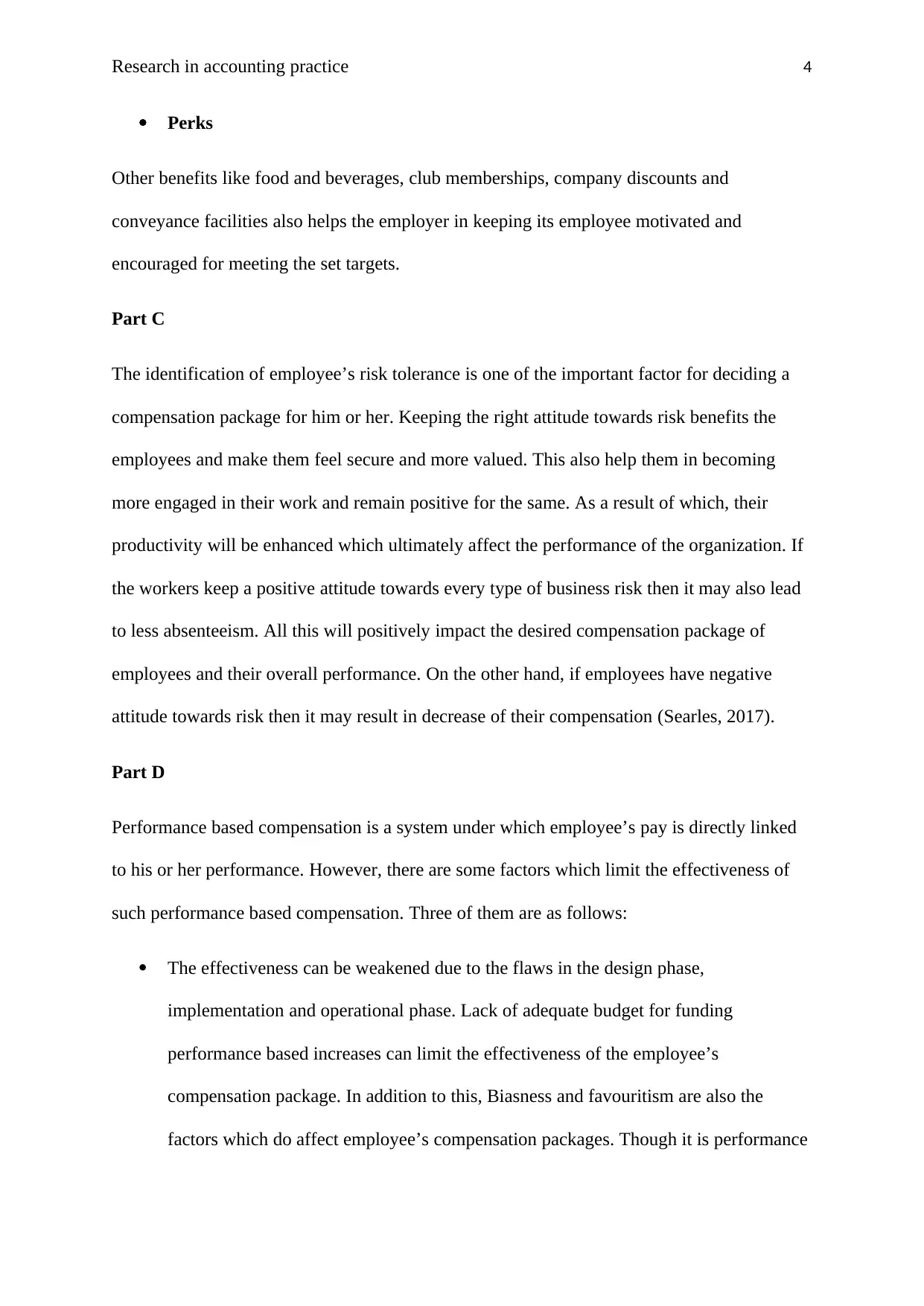
Research in accounting practice 4
Perks
Other benefits like food and beverages, club memberships, company discounts and
conveyance facilities also helps the employer in keeping its employee motivated and
encouraged for meeting the set targets.
Part C
The identification of employee’s risk tolerance is one of the important factor for deciding a
compensation package for him or her. Keeping the right attitude towards risk benefits the
employees and make them feel secure and more valued. This also help them in becoming
more engaged in their work and remain positive for the same. As a result of which, their
productivity will be enhanced which ultimately affect the performance of the organization. If
the workers keep a positive attitude towards every type of business risk then it may also lead
to less absenteeism. All this will positively impact the desired compensation package of
employees and their overall performance. On the other hand, if employees have negative
attitude towards risk then it may result in decrease of their compensation (Searles, 2017).
Part D
Performance based compensation is a system under which employee’s pay is directly linked
to his or her performance. However, there are some factors which limit the effectiveness of
such performance based compensation. Three of them are as follows:
The effectiveness can be weakened due to the flaws in the design phase,
implementation and operational phase. Lack of adequate budget for funding
performance based increases can limit the effectiveness of the employee’s
compensation package. In addition to this, Biasness and favouritism are also the
factors which do affect employee’s compensation packages. Though it is performance
Perks
Other benefits like food and beverages, club memberships, company discounts and
conveyance facilities also helps the employer in keeping its employee motivated and
encouraged for meeting the set targets.
Part C
The identification of employee’s risk tolerance is one of the important factor for deciding a
compensation package for him or her. Keeping the right attitude towards risk benefits the
employees and make them feel secure and more valued. This also help them in becoming
more engaged in their work and remain positive for the same. As a result of which, their
productivity will be enhanced which ultimately affect the performance of the organization. If
the workers keep a positive attitude towards every type of business risk then it may also lead
to less absenteeism. All this will positively impact the desired compensation package of
employees and their overall performance. On the other hand, if employees have negative
attitude towards risk then it may result in decrease of their compensation (Searles, 2017).
Part D
Performance based compensation is a system under which employee’s pay is directly linked
to his or her performance. However, there are some factors which limit the effectiveness of
such performance based compensation. Three of them are as follows:
The effectiveness can be weakened due to the flaws in the design phase,
implementation and operational phase. Lack of adequate budget for funding
performance based increases can limit the effectiveness of the employee’s
compensation package. In addition to this, Biasness and favouritism are also the
factors which do affect employee’s compensation packages. Though it is performance
Paraphrase This Document
Need a fresh take? Get an instant paraphrase of this document with our AI Paraphraser
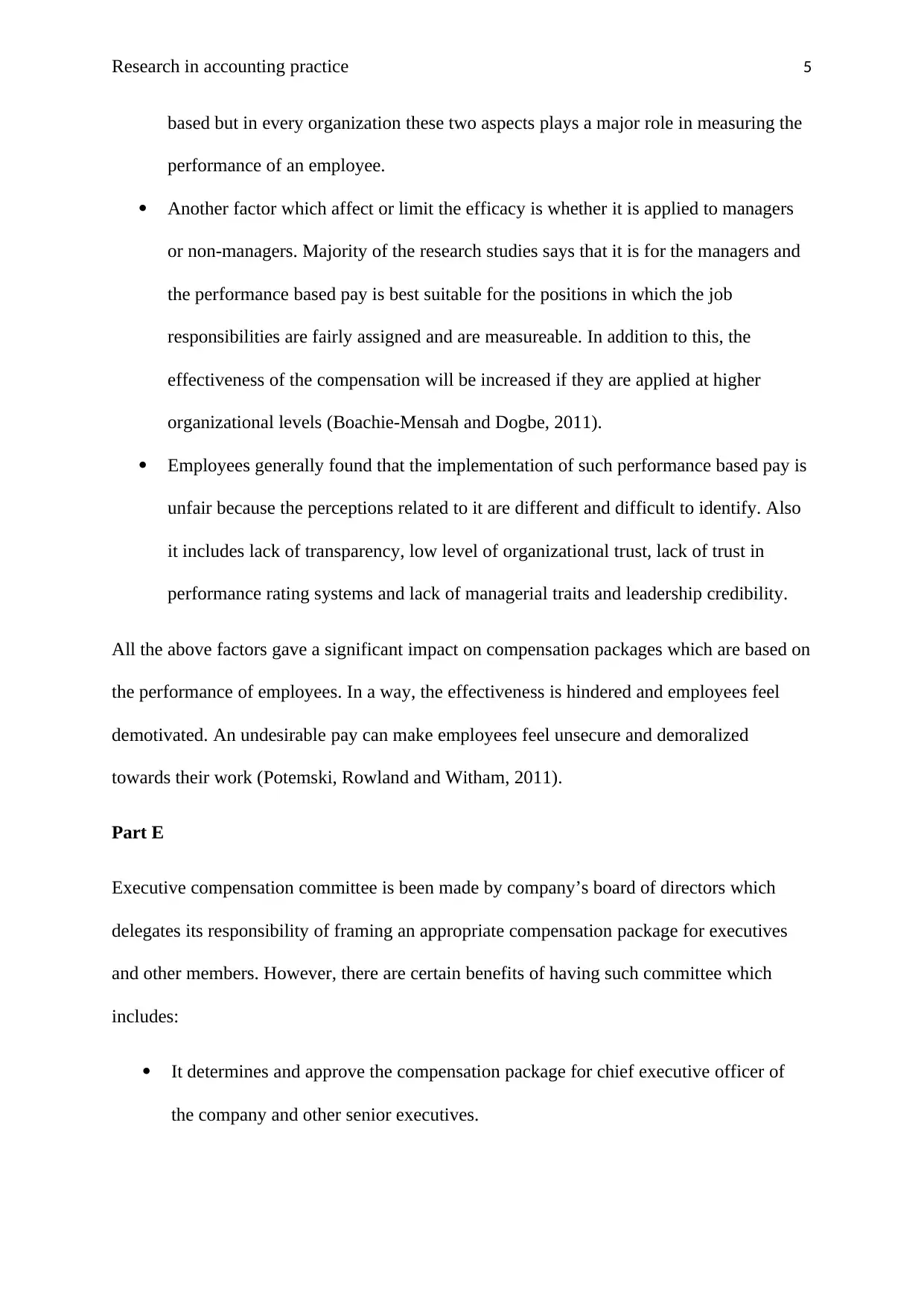
Research in accounting practice 5
based but in every organization these two aspects plays a major role in measuring the
performance of an employee.
Another factor which affect or limit the efficacy is whether it is applied to managers
or non-managers. Majority of the research studies says that it is for the managers and
the performance based pay is best suitable for the positions in which the job
responsibilities are fairly assigned and are measureable. In addition to this, the
effectiveness of the compensation will be increased if they are applied at higher
organizational levels (Boachie-Mensah and Dogbe, 2011).
Employees generally found that the implementation of such performance based pay is
unfair because the perceptions related to it are different and difficult to identify. Also
it includes lack of transparency, low level of organizational trust, lack of trust in
performance rating systems and lack of managerial traits and leadership credibility.
All the above factors gave a significant impact on compensation packages which are based on
the performance of employees. In a way, the effectiveness is hindered and employees feel
demotivated. An undesirable pay can make employees feel unsecure and demoralized
towards their work (Potemski, Rowland and Witham, 2011).
Part E
Executive compensation committee is been made by company’s board of directors which
delegates its responsibility of framing an appropriate compensation package for executives
and other members. However, there are certain benefits of having such committee which
includes:
It determines and approve the compensation package for chief executive officer of
the company and other senior executives.
based but in every organization these two aspects plays a major role in measuring the
performance of an employee.
Another factor which affect or limit the efficacy is whether it is applied to managers
or non-managers. Majority of the research studies says that it is for the managers and
the performance based pay is best suitable for the positions in which the job
responsibilities are fairly assigned and are measureable. In addition to this, the
effectiveness of the compensation will be increased if they are applied at higher
organizational levels (Boachie-Mensah and Dogbe, 2011).
Employees generally found that the implementation of such performance based pay is
unfair because the perceptions related to it are different and difficult to identify. Also
it includes lack of transparency, low level of organizational trust, lack of trust in
performance rating systems and lack of managerial traits and leadership credibility.
All the above factors gave a significant impact on compensation packages which are based on
the performance of employees. In a way, the effectiveness is hindered and employees feel
demotivated. An undesirable pay can make employees feel unsecure and demoralized
towards their work (Potemski, Rowland and Witham, 2011).
Part E
Executive compensation committee is been made by company’s board of directors which
delegates its responsibility of framing an appropriate compensation package for executives
and other members. However, there are certain benefits of having such committee which
includes:
It determines and approve the compensation package for chief executive officer of
the company and other senior executives.
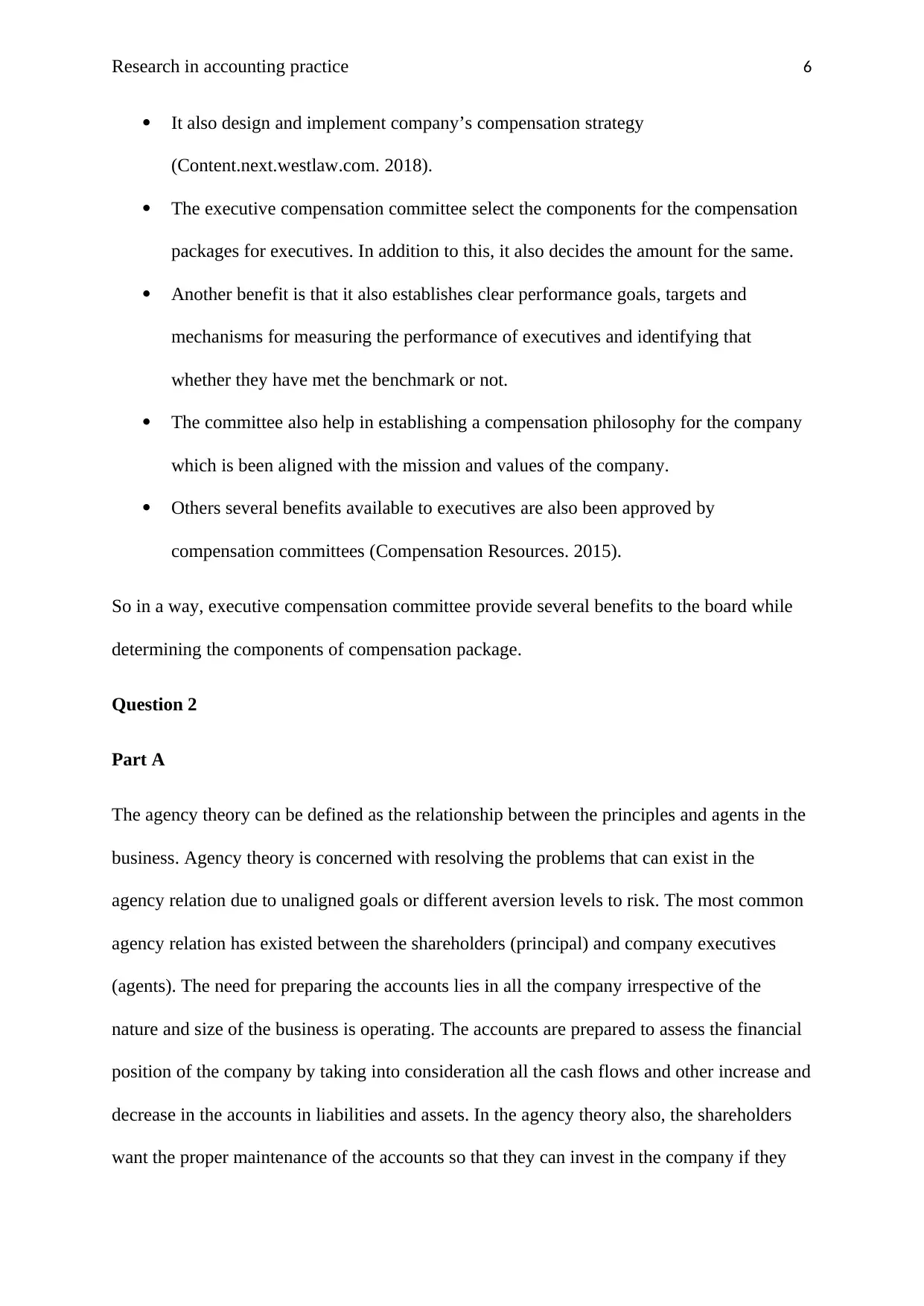
Research in accounting practice 6
It also design and implement company’s compensation strategy
(Content.next.westlaw.com. 2018).
The executive compensation committee select the components for the compensation
packages for executives. In addition to this, it also decides the amount for the same.
Another benefit is that it also establishes clear performance goals, targets and
mechanisms for measuring the performance of executives and identifying that
whether they have met the benchmark or not.
The committee also help in establishing a compensation philosophy for the company
which is been aligned with the mission and values of the company.
Others several benefits available to executives are also been approved by
compensation committees (Compensation Resources. 2015).
So in a way, executive compensation committee provide several benefits to the board while
determining the components of compensation package.
Question 2
Part A
The agency theory can be defined as the relationship between the principles and agents in the
business. Agency theory is concerned with resolving the problems that can exist in the
agency relation due to unaligned goals or different aversion levels to risk. The most common
agency relation has existed between the shareholders (principal) and company executives
(agents). The need for preparing the accounts lies in all the company irrespective of the
nature and size of the business is operating. The accounts are prepared to assess the financial
position of the company by taking into consideration all the cash flows and other increase and
decrease in the accounts in liabilities and assets. In the agency theory also, the shareholders
want the proper maintenance of the accounts so that they can invest in the company if they
It also design and implement company’s compensation strategy
(Content.next.westlaw.com. 2018).
The executive compensation committee select the components for the compensation
packages for executives. In addition to this, it also decides the amount for the same.
Another benefit is that it also establishes clear performance goals, targets and
mechanisms for measuring the performance of executives and identifying that
whether they have met the benchmark or not.
The committee also help in establishing a compensation philosophy for the company
which is been aligned with the mission and values of the company.
Others several benefits available to executives are also been approved by
compensation committees (Compensation Resources. 2015).
So in a way, executive compensation committee provide several benefits to the board while
determining the components of compensation package.
Question 2
Part A
The agency theory can be defined as the relationship between the principles and agents in the
business. Agency theory is concerned with resolving the problems that can exist in the
agency relation due to unaligned goals or different aversion levels to risk. The most common
agency relation has existed between the shareholders (principal) and company executives
(agents). The need for preparing the accounts lies in all the company irrespective of the
nature and size of the business is operating. The accounts are prepared to assess the financial
position of the company by taking into consideration all the cash flows and other increase and
decrease in the accounts in liabilities and assets. In the agency theory also, the shareholders
want the proper maintenance of the accounts so that they can invest in the company if they
⊘ This is a preview!⊘
Do you want full access?
Subscribe today to unlock all pages.

Trusted by 1+ million students worldwide
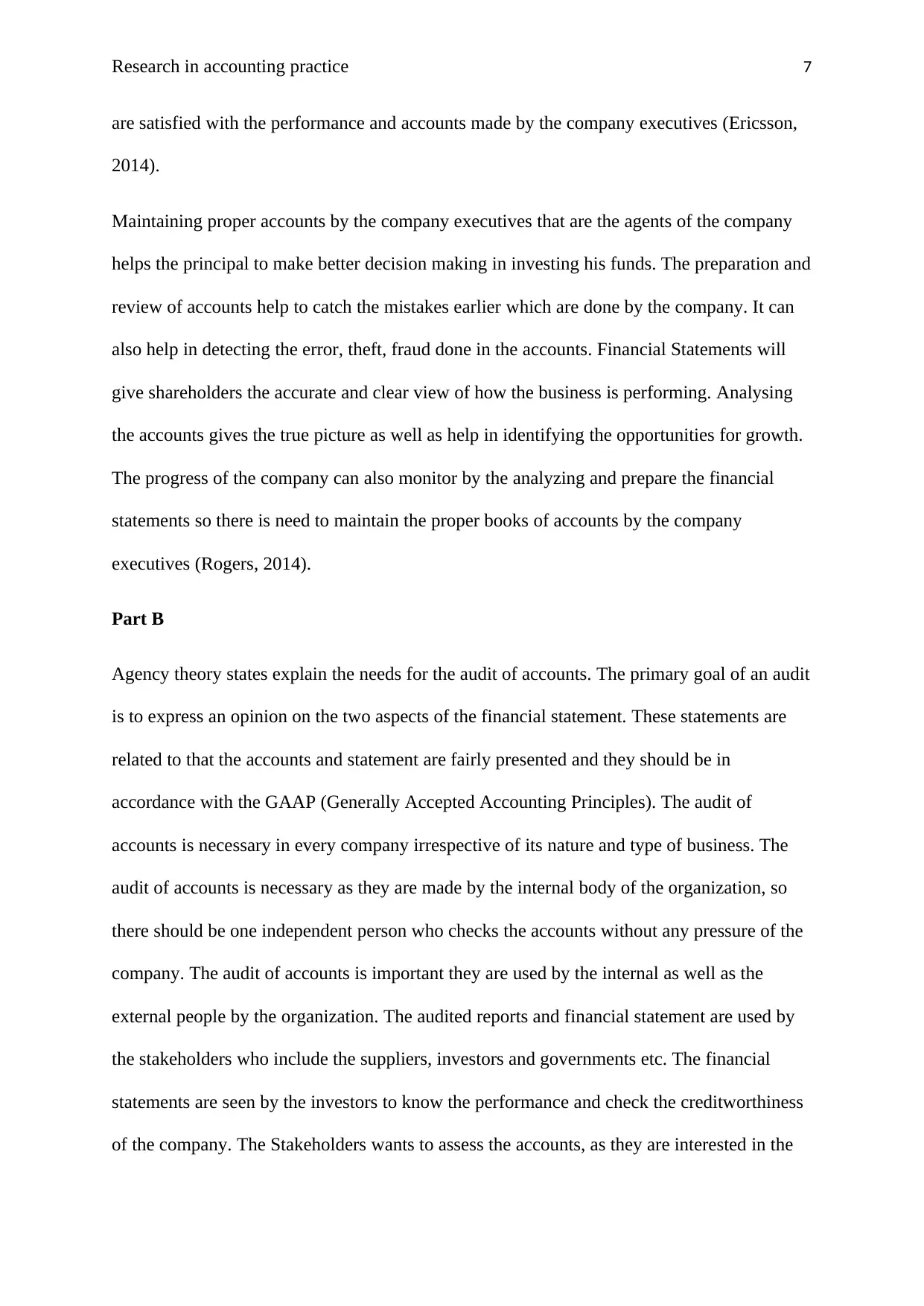
Research in accounting practice 7
are satisfied with the performance and accounts made by the company executives (Ericsson,
2014).
Maintaining proper accounts by the company executives that are the agents of the company
helps the principal to make better decision making in investing his funds. The preparation and
review of accounts help to catch the mistakes earlier which are done by the company. It can
also help in detecting the error, theft, fraud done in the accounts. Financial Statements will
give shareholders the accurate and clear view of how the business is performing. Analysing
the accounts gives the true picture as well as help in identifying the opportunities for growth.
The progress of the company can also monitor by the analyzing and prepare the financial
statements so there is need to maintain the proper books of accounts by the company
executives (Rogers, 2014).
Part B
Agency theory states explain the needs for the audit of accounts. The primary goal of an audit
is to express an opinion on the two aspects of the financial statement. These statements are
related to that the accounts and statement are fairly presented and they should be in
accordance with the GAAP (Generally Accepted Accounting Principles). The audit of
accounts is necessary in every company irrespective of its nature and type of business. The
audit of accounts is necessary as they are made by the internal body of the organization, so
there should be one independent person who checks the accounts without any pressure of the
company. The audit of accounts is important they are used by the internal as well as the
external people by the organization. The audited reports and financial statement are used by
the stakeholders who include the suppliers, investors and governments etc. The financial
statements are seen by the investors to know the performance and check the creditworthiness
of the company. The Stakeholders wants to assess the accounts, as they are interested in the
are satisfied with the performance and accounts made by the company executives (Ericsson,
2014).
Maintaining proper accounts by the company executives that are the agents of the company
helps the principal to make better decision making in investing his funds. The preparation and
review of accounts help to catch the mistakes earlier which are done by the company. It can
also help in detecting the error, theft, fraud done in the accounts. Financial Statements will
give shareholders the accurate and clear view of how the business is performing. Analysing
the accounts gives the true picture as well as help in identifying the opportunities for growth.
The progress of the company can also monitor by the analyzing and prepare the financial
statements so there is need to maintain the proper books of accounts by the company
executives (Rogers, 2014).
Part B
Agency theory states explain the needs for the audit of accounts. The primary goal of an audit
is to express an opinion on the two aspects of the financial statement. These statements are
related to that the accounts and statement are fairly presented and they should be in
accordance with the GAAP (Generally Accepted Accounting Principles). The audit of
accounts is necessary in every company irrespective of its nature and type of business. The
audit of accounts is necessary as they are made by the internal body of the organization, so
there should be one independent person who checks the accounts without any pressure of the
company. The audit of accounts is important they are used by the internal as well as the
external people by the organization. The audited reports and financial statement are used by
the stakeholders who include the suppliers, investors and governments etc. The financial
statements are seen by the investors to know the performance and check the creditworthiness
of the company. The Stakeholders wants to assess the accounts, as they are interested in the
Paraphrase This Document
Need a fresh take? Get an instant paraphrase of this document with our AI Paraphraser
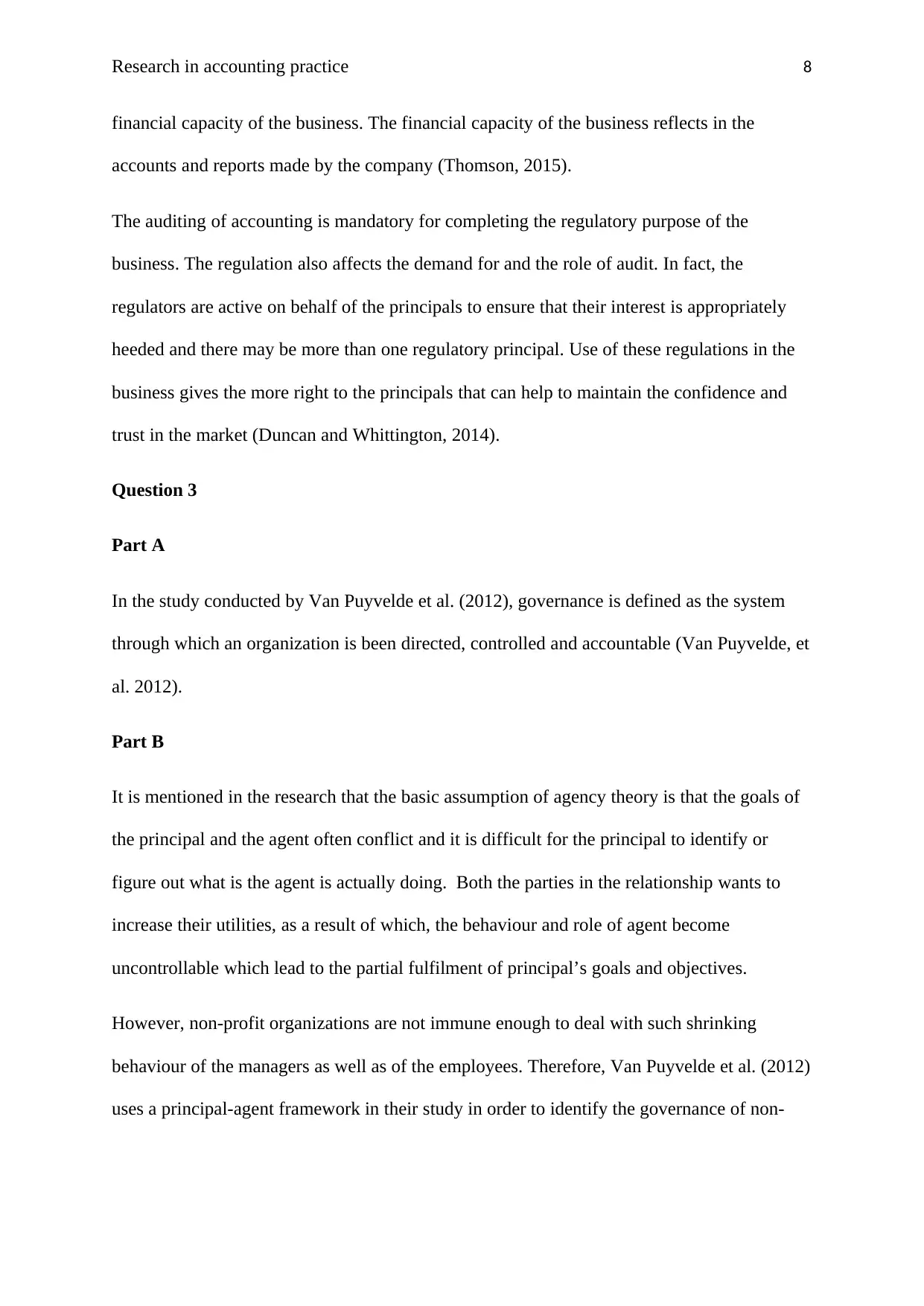
Research in accounting practice 8
financial capacity of the business. The financial capacity of the business reflects in the
accounts and reports made by the company (Thomson, 2015).
The auditing of accounting is mandatory for completing the regulatory purpose of the
business. The regulation also affects the demand for and the role of audit. In fact, the
regulators are active on behalf of the principals to ensure that their interest is appropriately
heeded and there may be more than one regulatory principal. Use of these regulations in the
business gives the more right to the principals that can help to maintain the confidence and
trust in the market (Duncan and Whittington, 2014).
Question 3
Part A
In the study conducted by Van Puyvelde et al. (2012), governance is defined as the system
through which an organization is been directed, controlled and accountable (Van Puyvelde, et
al. 2012).
Part B
It is mentioned in the research that the basic assumption of agency theory is that the goals of
the principal and the agent often conflict and it is difficult for the principal to identify or
figure out what is the agent is actually doing. Both the parties in the relationship wants to
increase their utilities, as a result of which, the behaviour and role of agent become
uncontrollable which lead to the partial fulfilment of principal’s goals and objectives.
However, non-profit organizations are not immune enough to deal with such shrinking
behaviour of the managers as well as of the employees. Therefore, Van Puyvelde et al. (2012)
uses a principal-agent framework in their study in order to identify the governance of non-
financial capacity of the business. The financial capacity of the business reflects in the
accounts and reports made by the company (Thomson, 2015).
The auditing of accounting is mandatory for completing the regulatory purpose of the
business. The regulation also affects the demand for and the role of audit. In fact, the
regulators are active on behalf of the principals to ensure that their interest is appropriately
heeded and there may be more than one regulatory principal. Use of these regulations in the
business gives the more right to the principals that can help to maintain the confidence and
trust in the market (Duncan and Whittington, 2014).
Question 3
Part A
In the study conducted by Van Puyvelde et al. (2012), governance is defined as the system
through which an organization is been directed, controlled and accountable (Van Puyvelde, et
al. 2012).
Part B
It is mentioned in the research that the basic assumption of agency theory is that the goals of
the principal and the agent often conflict and it is difficult for the principal to identify or
figure out what is the agent is actually doing. Both the parties in the relationship wants to
increase their utilities, as a result of which, the behaviour and role of agent become
uncontrollable which lead to the partial fulfilment of principal’s goals and objectives.
However, non-profit organizations are not immune enough to deal with such shrinking
behaviour of the managers as well as of the employees. Therefore, Van Puyvelde et al. (2012)
uses a principal-agent framework in their study in order to identify the governance of non-
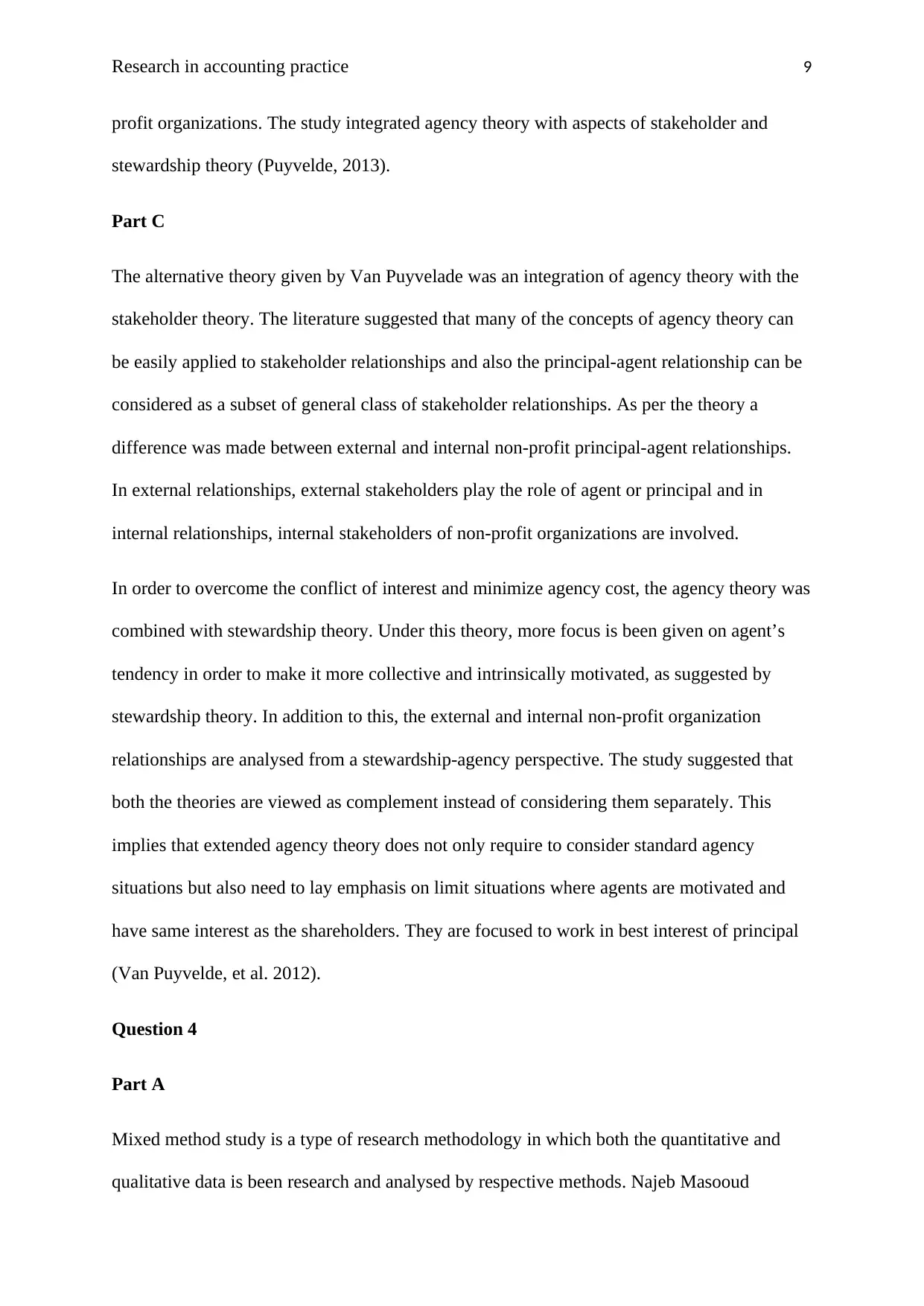
Research in accounting practice 9
profit organizations. The study integrated agency theory with aspects of stakeholder and
stewardship theory (Puyvelde, 2013).
Part C
The alternative theory given by Van Puyvelade was an integration of agency theory with the
stakeholder theory. The literature suggested that many of the concepts of agency theory can
be easily applied to stakeholder relationships and also the principal-agent relationship can be
considered as a subset of general class of stakeholder relationships. As per the theory a
difference was made between external and internal non-profit principal-agent relationships.
In external relationships, external stakeholders play the role of agent or principal and in
internal relationships, internal stakeholders of non-profit organizations are involved.
In order to overcome the conflict of interest and minimize agency cost, the agency theory was
combined with stewardship theory. Under this theory, more focus is been given on agent’s
tendency in order to make it more collective and intrinsically motivated, as suggested by
stewardship theory. In addition to this, the external and internal non-profit organization
relationships are analysed from a stewardship-agency perspective. The study suggested that
both the theories are viewed as complement instead of considering them separately. This
implies that extended agency theory does not only require to consider standard agency
situations but also need to lay emphasis on limit situations where agents are motivated and
have same interest as the shareholders. They are focused to work in best interest of principal
(Van Puyvelde, et al. 2012).
Question 4
Part A
Mixed method study is a type of research methodology in which both the quantitative and
qualitative data is been research and analysed by respective methods. Najeb Masooud
profit organizations. The study integrated agency theory with aspects of stakeholder and
stewardship theory (Puyvelde, 2013).
Part C
The alternative theory given by Van Puyvelade was an integration of agency theory with the
stakeholder theory. The literature suggested that many of the concepts of agency theory can
be easily applied to stakeholder relationships and also the principal-agent relationship can be
considered as a subset of general class of stakeholder relationships. As per the theory a
difference was made between external and internal non-profit principal-agent relationships.
In external relationships, external stakeholders play the role of agent or principal and in
internal relationships, internal stakeholders of non-profit organizations are involved.
In order to overcome the conflict of interest and minimize agency cost, the agency theory was
combined with stewardship theory. Under this theory, more focus is been given on agent’s
tendency in order to make it more collective and intrinsically motivated, as suggested by
stewardship theory. In addition to this, the external and internal non-profit organization
relationships are analysed from a stewardship-agency perspective. The study suggested that
both the theories are viewed as complement instead of considering them separately. This
implies that extended agency theory does not only require to consider standard agency
situations but also need to lay emphasis on limit situations where agents are motivated and
have same interest as the shareholders. They are focused to work in best interest of principal
(Van Puyvelde, et al. 2012).
Question 4
Part A
Mixed method study is a type of research methodology in which both the quantitative and
qualitative data is been research and analysed by respective methods. Najeb Masooud
⊘ This is a preview!⊘
Do you want full access?
Subscribe today to unlock all pages.

Trusted by 1+ million students worldwide
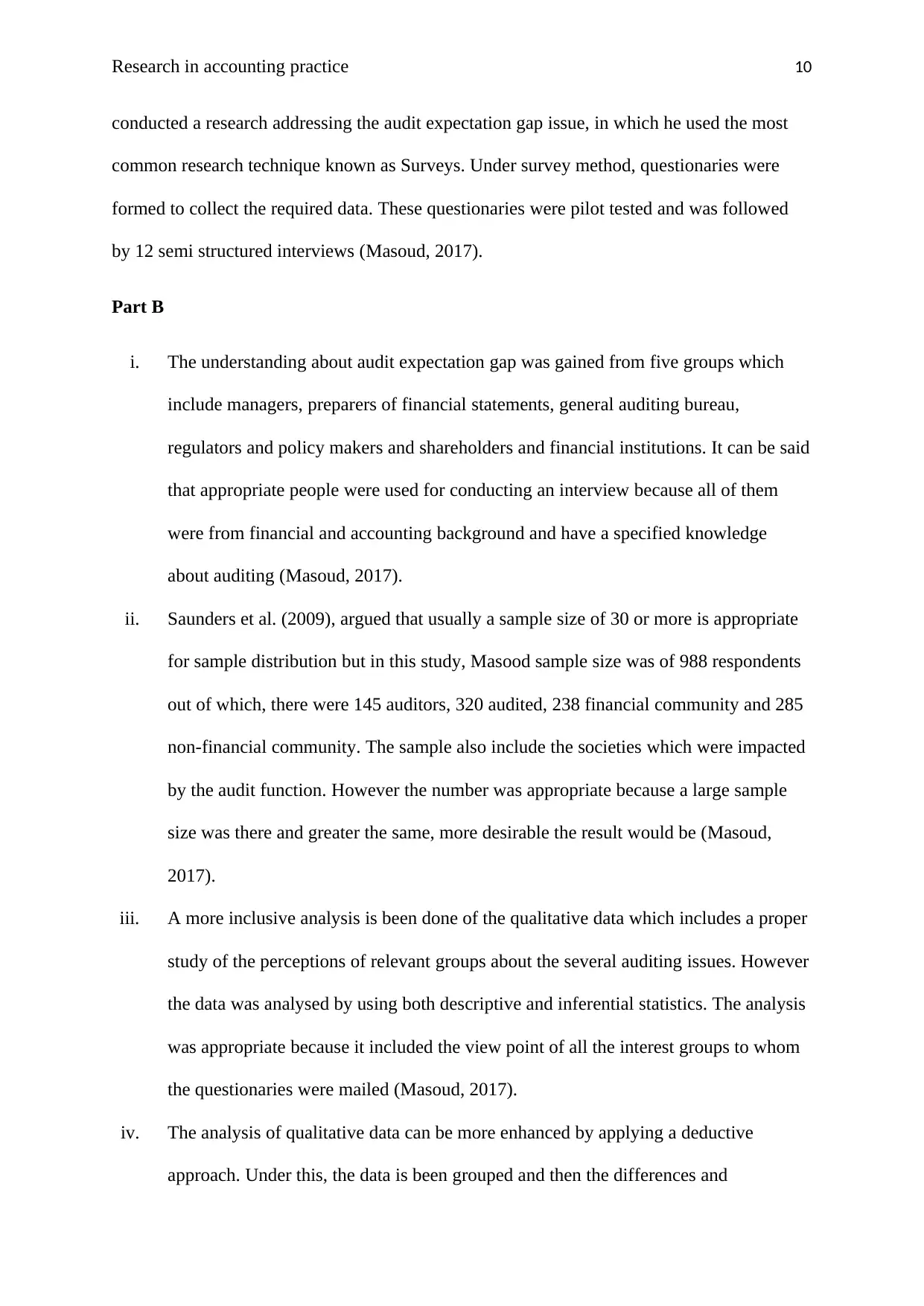
Research in accounting practice 10
conducted a research addressing the audit expectation gap issue, in which he used the most
common research technique known as Surveys. Under survey method, questionaries were
formed to collect the required data. These questionaries were pilot tested and was followed
by 12 semi structured interviews (Masoud, 2017).
Part B
i. The understanding about audit expectation gap was gained from five groups which
include managers, preparers of financial statements, general auditing bureau,
regulators and policy makers and shareholders and financial institutions. It can be said
that appropriate people were used for conducting an interview because all of them
were from financial and accounting background and have a specified knowledge
about auditing (Masoud, 2017).
ii. Saunders et al. (2009), argued that usually a sample size of 30 or more is appropriate
for sample distribution but in this study, Masood sample size was of 988 respondents
out of which, there were 145 auditors, 320 audited, 238 financial community and 285
non-financial community. The sample also include the societies which were impacted
by the audit function. However the number was appropriate because a large sample
size was there and greater the same, more desirable the result would be (Masoud,
2017).
iii. A more inclusive analysis is been done of the qualitative data which includes a proper
study of the perceptions of relevant groups about the several auditing issues. However
the data was analysed by using both descriptive and inferential statistics. The analysis
was appropriate because it included the view point of all the interest groups to whom
the questionaries were mailed (Masoud, 2017).
iv. The analysis of qualitative data can be more enhanced by applying a deductive
approach. Under this, the data is been grouped and then the differences and
conducted a research addressing the audit expectation gap issue, in which he used the most
common research technique known as Surveys. Under survey method, questionaries were
formed to collect the required data. These questionaries were pilot tested and was followed
by 12 semi structured interviews (Masoud, 2017).
Part B
i. The understanding about audit expectation gap was gained from five groups which
include managers, preparers of financial statements, general auditing bureau,
regulators and policy makers and shareholders and financial institutions. It can be said
that appropriate people were used for conducting an interview because all of them
were from financial and accounting background and have a specified knowledge
about auditing (Masoud, 2017).
ii. Saunders et al. (2009), argued that usually a sample size of 30 or more is appropriate
for sample distribution but in this study, Masood sample size was of 988 respondents
out of which, there were 145 auditors, 320 audited, 238 financial community and 285
non-financial community. The sample also include the societies which were impacted
by the audit function. However the number was appropriate because a large sample
size was there and greater the same, more desirable the result would be (Masoud,
2017).
iii. A more inclusive analysis is been done of the qualitative data which includes a proper
study of the perceptions of relevant groups about the several auditing issues. However
the data was analysed by using both descriptive and inferential statistics. The analysis
was appropriate because it included the view point of all the interest groups to whom
the questionaries were mailed (Masoud, 2017).
iv. The analysis of qualitative data can be more enhanced by applying a deductive
approach. Under this, the data is been grouped and then the differences and
Paraphrase This Document
Need a fresh take? Get an instant paraphrase of this document with our AI Paraphraser
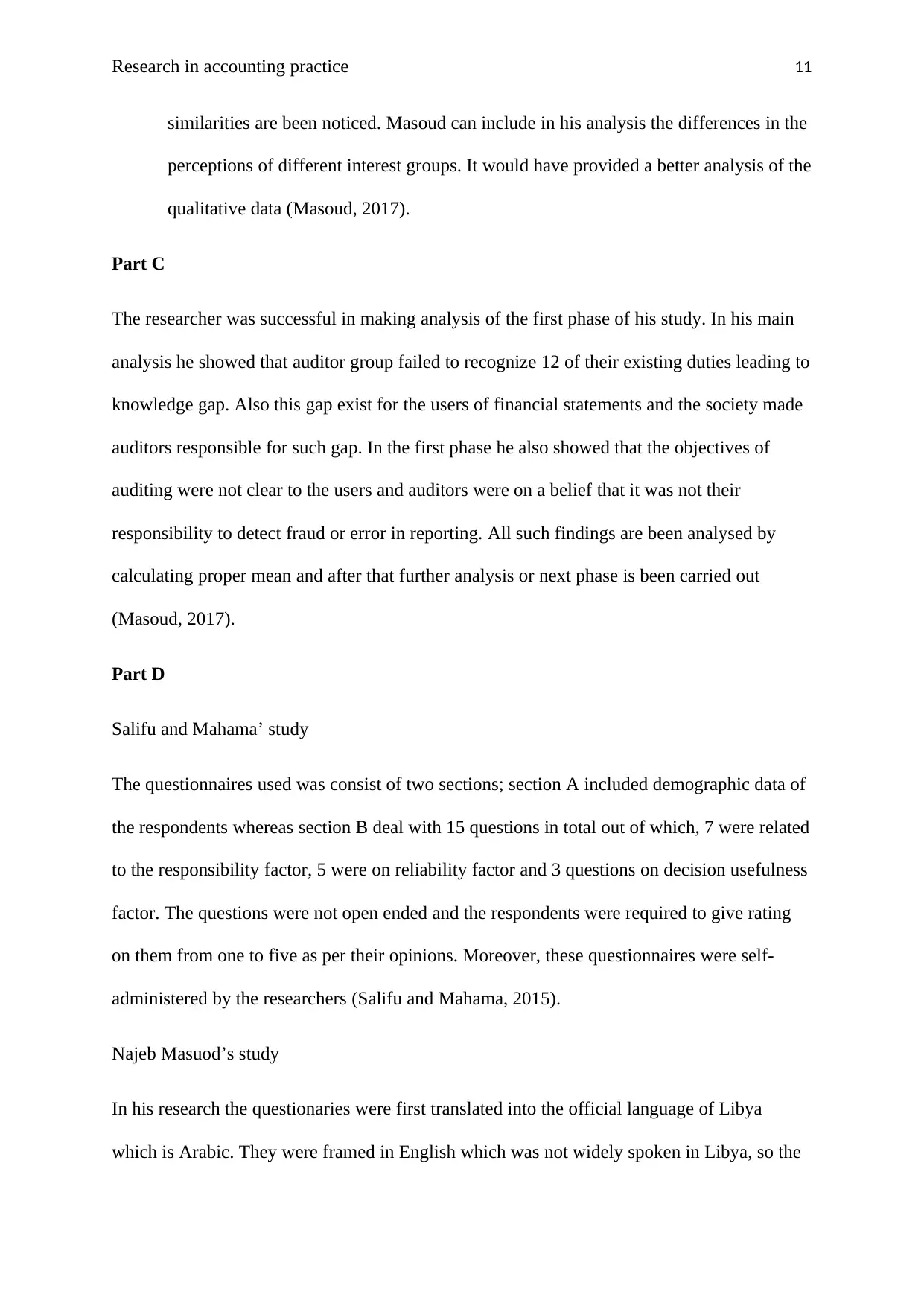
Research in accounting practice 11
similarities are been noticed. Masoud can include in his analysis the differences in the
perceptions of different interest groups. It would have provided a better analysis of the
qualitative data (Masoud, 2017).
Part C
The researcher was successful in making analysis of the first phase of his study. In his main
analysis he showed that auditor group failed to recognize 12 of their existing duties leading to
knowledge gap. Also this gap exist for the users of financial statements and the society made
auditors responsible for such gap. In the first phase he also showed that the objectives of
auditing were not clear to the users and auditors were on a belief that it was not their
responsibility to detect fraud or error in reporting. All such findings are been analysed by
calculating proper mean and after that further analysis or next phase is been carried out
(Masoud, 2017).
Part D
Salifu and Mahama’ study
The questionnaires used was consist of two sections; section A included demographic data of
the respondents whereas section B deal with 15 questions in total out of which, 7 were related
to the responsibility factor, 5 were on reliability factor and 3 questions on decision usefulness
factor. The questions were not open ended and the respondents were required to give rating
on them from one to five as per their opinions. Moreover, these questionnaires were self-
administered by the researchers (Salifu and Mahama, 2015).
Najeb Masuod’s study
In his research the questionaries were first translated into the official language of Libya
which is Arabic. They were framed in English which was not widely spoken in Libya, so the
similarities are been noticed. Masoud can include in his analysis the differences in the
perceptions of different interest groups. It would have provided a better analysis of the
qualitative data (Masoud, 2017).
Part C
The researcher was successful in making analysis of the first phase of his study. In his main
analysis he showed that auditor group failed to recognize 12 of their existing duties leading to
knowledge gap. Also this gap exist for the users of financial statements and the society made
auditors responsible for such gap. In the first phase he also showed that the objectives of
auditing were not clear to the users and auditors were on a belief that it was not their
responsibility to detect fraud or error in reporting. All such findings are been analysed by
calculating proper mean and after that further analysis or next phase is been carried out
(Masoud, 2017).
Part D
Salifu and Mahama’ study
The questionnaires used was consist of two sections; section A included demographic data of
the respondents whereas section B deal with 15 questions in total out of which, 7 were related
to the responsibility factor, 5 were on reliability factor and 3 questions on decision usefulness
factor. The questions were not open ended and the respondents were required to give rating
on them from one to five as per their opinions. Moreover, these questionnaires were self-
administered by the researchers (Salifu and Mahama, 2015).
Najeb Masuod’s study
In his research the questionaries were first translated into the official language of Libya
which is Arabic. They were framed in English which was not widely spoken in Libya, so the
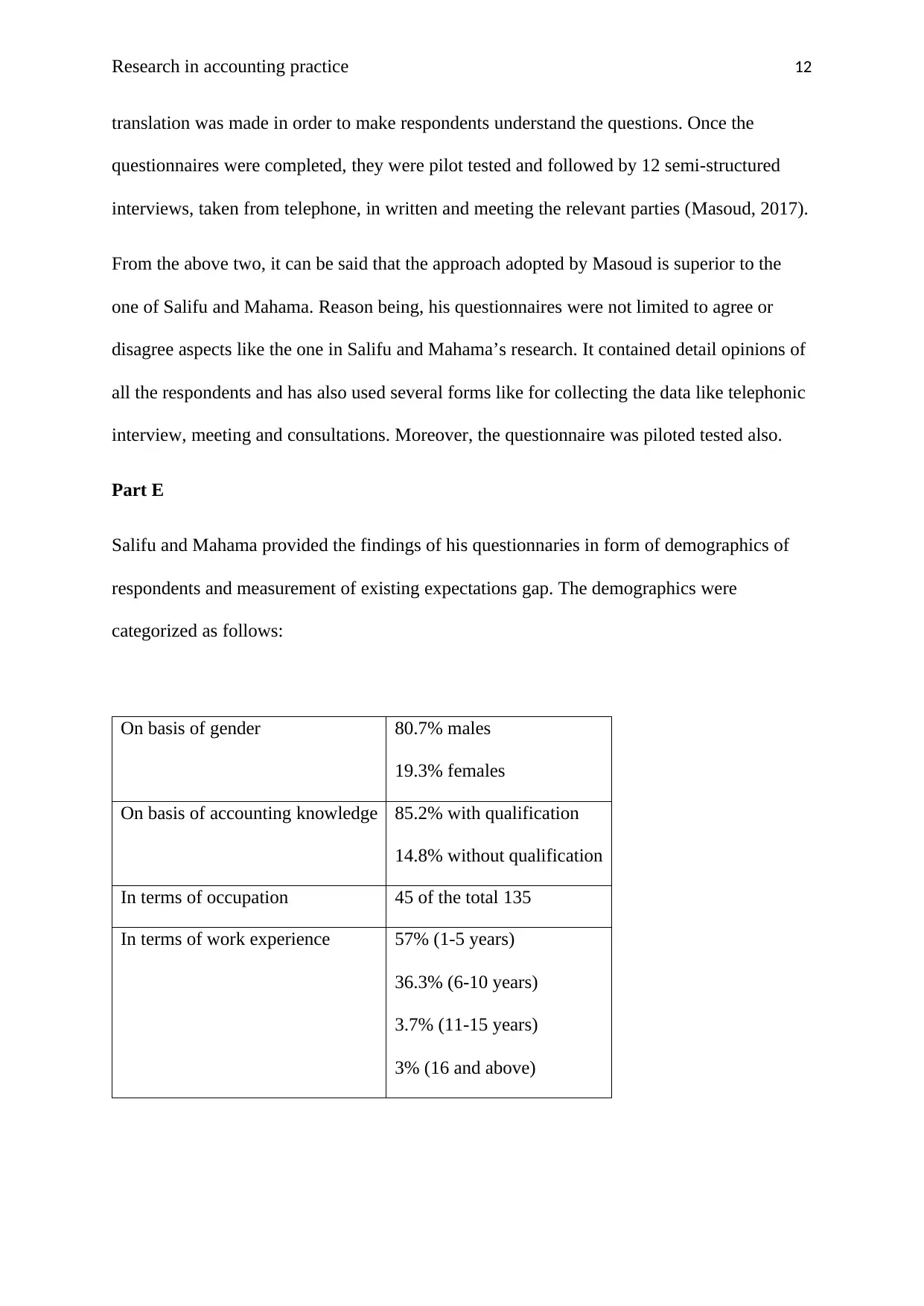
Research in accounting practice 12
translation was made in order to make respondents understand the questions. Once the
questionnaires were completed, they were pilot tested and followed by 12 semi-structured
interviews, taken from telephone, in written and meeting the relevant parties (Masoud, 2017).
From the above two, it can be said that the approach adopted by Masoud is superior to the
one of Salifu and Mahama. Reason being, his questionnaires were not limited to agree or
disagree aspects like the one in Salifu and Mahama’s research. It contained detail opinions of
all the respondents and has also used several forms like for collecting the data like telephonic
interview, meeting and consultations. Moreover, the questionnaire was piloted tested also.
Part E
Salifu and Mahama provided the findings of his questionnaries in form of demographics of
respondents and measurement of existing expectations gap. The demographics were
categorized as follows:
On basis of gender 80.7% males
19.3% females
On basis of accounting knowledge 85.2% with qualification
14.8% without qualification
In terms of occupation 45 of the total 135
In terms of work experience 57% (1-5 years)
36.3% (6-10 years)
3.7% (11-15 years)
3% (16 and above)
translation was made in order to make respondents understand the questions. Once the
questionnaires were completed, they were pilot tested and followed by 12 semi-structured
interviews, taken from telephone, in written and meeting the relevant parties (Masoud, 2017).
From the above two, it can be said that the approach adopted by Masoud is superior to the
one of Salifu and Mahama. Reason being, his questionnaires were not limited to agree or
disagree aspects like the one in Salifu and Mahama’s research. It contained detail opinions of
all the respondents and has also used several forms like for collecting the data like telephonic
interview, meeting and consultations. Moreover, the questionnaire was piloted tested also.
Part E
Salifu and Mahama provided the findings of his questionnaries in form of demographics of
respondents and measurement of existing expectations gap. The demographics were
categorized as follows:
On basis of gender 80.7% males
19.3% females
On basis of accounting knowledge 85.2% with qualification
14.8% without qualification
In terms of occupation 45 of the total 135
In terms of work experience 57% (1-5 years)
36.3% (6-10 years)
3.7% (11-15 years)
3% (16 and above)
⊘ This is a preview!⊘
Do you want full access?
Subscribe today to unlock all pages.

Trusted by 1+ million students worldwide
1 out of 18
Related Documents
Your All-in-One AI-Powered Toolkit for Academic Success.
+13062052269
info@desklib.com
Available 24*7 on WhatsApp / Email
![[object Object]](/_next/static/media/star-bottom.7253800d.svg)
Unlock your academic potential
Copyright © 2020–2025 A2Z Services. All Rights Reserved. Developed and managed by ZUCOL.




